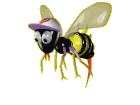
Just the Facts |

![]() The
number of bees in a hive varies according to availability of nectar and pollen
from less than 5000 to more than 100,000.
The
number of bees in a hive varies according to availability of nectar and pollen
from less than 5000 to more than 100,000.
![]() During honey flows foraging bees wear
their wings to shreds over 2 weeks and become prey for ants and other insects.
During honey flows foraging bees wear
their wings to shreds over 2 weeks and become prey for ants and other insects.
![]() Foraging
bees will make round trips of approximately 4 kilometres to and from the hive.
Foraging
bees will make round trips of approximately 4 kilometres to and from the hive.
![]() Bees
communicate to their fellow bees the source and location of nectar so the
foraging bees concentrate on one flowering species at a time.
Bees
communicate to their fellow bees the source and location of nectar so the
foraging bees concentrate on one flowering species at a time.
![]() When
a nectar source is abundant, 90% of the honey/pollen will be from that source.
When
a nectar source is abundant, 90% of the honey/pollen will be from that source.
![]() Each
hive has one queen who bequeaths the hive to a daughter.
Each
hive has one queen who bequeaths the hive to a daughter.
![]() A
queen bee will lay up to 2,000 eggs a day.
A
queen bee will lay up to 2,000 eggs a day.
![]() The
queen’s attendant bees groom and feed her, up to 80 times her weight daily.
The
queen’s attendant bees groom and feed her, up to 80 times her weight daily.
![]() Honey
bees evolved between 150 - 180 million years ago.
Honey
bees evolved between 150 - 180 million years ago.
![]() Bees
can carry nearly their own weight in nectar and pollen.
Bees
can carry nearly their own weight in nectar and pollen.
![]() Bees
attempting to enter a different hive will be killed as intruders although bees
returning with nectar may be admitted.
Bees
attempting to enter a different hive will be killed as intruders although bees
returning with nectar may be admitted.
![]() All
bees in a hive share a common odor, emanating from the queen’s pheromones.
All
bees in a hive share a common odor, emanating from the queen’s pheromones.
![]() Bees
communicate by vibration and chemical cues. They are deaf to most sounds and are
mute.
Bees
communicate by vibration and chemical cues. They are deaf to most sounds and are
mute.
![]() Beekeepers
migrate hives between forest and agricultural crops to ensure year-round hive
strength and honey production.
Beekeepers
migrate hives between forest and agricultural crops to ensure year-round hive
strength and honey production.
![]() Honey
bees will sting in defense of their hive or their lives.
Honey
bees will sting in defense of their hive or their lives.
![]() A
cave painting in Spain dated to 15,000 B.C. shows 2 men climbing to a cave
containing bees and removing a honeycomb in a basket.
A
cave painting in Spain dated to 15,000 B.C. shows 2 men climbing to a cave
containing bees and removing a honeycomb in a basket.
![]() In
3000 B.C. Egyptians kept written records of beekeeping activities.
In
3000 B.C. Egyptians kept written records of beekeeping activities.
![]() Egyptian
hives were transported down the Nile on barges to access floral sources.
Egyptian
hives were transported down the Nile on barges to access floral sources.
![]() Roman
law declared that bees were the property of the man who placed them in a hive,
not the person who owned the land.
Roman
law declared that bees were the property of the man who placed them in a hive,
not the person who owned the land.
About pollination
![]() As
bees move over flowers, pollen sticks to their bodies and is transferred to the
next flowers visited, to pollinate seeds.
As
bees move over flowers, pollen sticks to their bodies and is transferred to the
next flowers visited, to pollinate seeds.
![]() Pollinated
fruit and seeds are up to 30% larger and have better germination.
Pollinated
fruit and seeds are up to 30% larger and have better germination.
![]() Many
flowering plants or trees depend upon insect pollination before fruit or seeds
will form.
Many
flowering plants or trees depend upon insect pollination before fruit or seeds
will form.
![]() One
bee can pollinate 18000 flowers per day.
One
bee can pollinate 18000 flowers per day.
![]() Beekeepers
move hives several times a year so bees can visit seasonal nectar sources or
pollinate crops.
Beekeepers
move hives several times a year so bees can visit seasonal nectar sources or
pollinate crops.
![]() Flowers
provide nectar to encourage pollination. Once this has been achieved, nectar
supply stops.
Flowers
provide nectar to encourage pollination. Once this has been achieved, nectar
supply stops.
![]() The
world faces continual famines without adequate pollination of trees and
agricultural crops.
The
world faces continual famines without adequate pollination of trees and
agricultural crops.